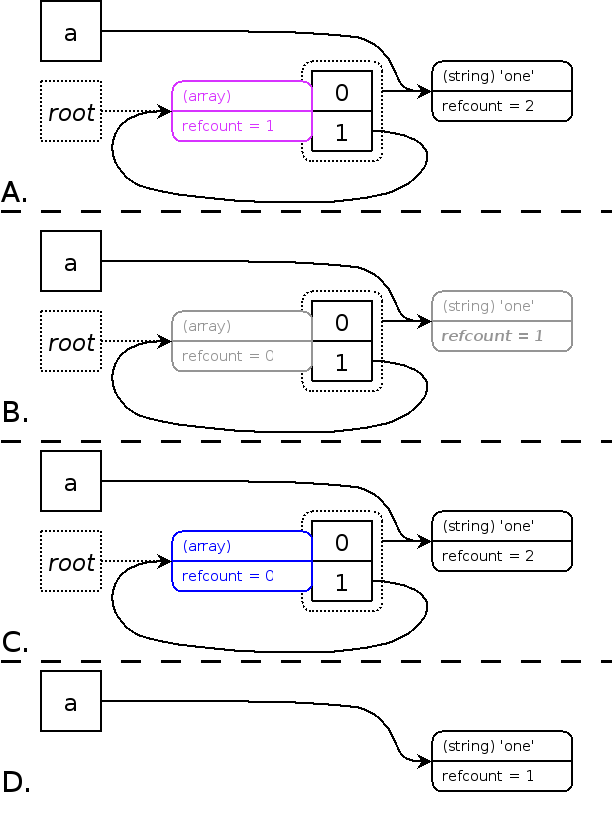After testing, breaking up memory intensive code into a separate function allows the garbage collection to work.
For example the original code was like:-
while(true){
//do memory intensive code
}
can be turned into something like:-
function intensive($parameters){
//do memory intensive code
}
while(true){
intensive($parameters);
}Collecting Cycles
Traditionally, reference counting memory mechanisms, such as that used previously by PHP, fail to address circular reference memory leaks; however, as of 5.3.0, PHP implements the synchronous algorithm from the » Concurrent Cycle Collection in Reference Counted Systems paper which addresses that issue.
A full explanation of how the algorithm works would be slightly beyond the scope of this section, but the basics are explained here. First of all, we have to establish a few ground rules. If a refcount is increased, it's still in use and therefore, not garbage. If the refcount is decreased and hits zero, the zval can be freed. This means that garbage cycles can only be created when a refcount argument is decreased to a non-zero value. Secondly, in a garbage cycle, it is possible to discover which parts are garbage by checking whether it is possible to decrease their refcount by one, and then checking which of the zvals have a refcount of zero.

To avoid having to call the checking of garbage cycles with every possible decrease of a refcount, the algorithm instead puts all possible roots (zvals) in the "root buffer" (marking them "purple"). It also makes sure that each possible garbage root ends up in the buffer only once. Only when the root buffer is full does the collection mechanism start for all the different zvals inside. See step A in the figure above.
In step B, the algorithm runs a depth-first search on all possible roots to decrease by one the refcounts of each zval it finds, making sure not to decrease a refcount on the same zval twice (by marking them as "grey"). In step C, the algorithm again runs a depth-first search from each root node, to check the refcount of each zval again. If it finds that the refcount is zero, the zval is marked "white" (blue in the figure). If it's larger than zero, it reverts the decreasing of the refcount by one with a depth-first search from that point on, and they are marked "black" again. In the last step (D), the algorithm walks over the root buffer removing the zval roots from there, and meanwhile, checks which zvals have been marked "white" in the previous step. Every zval marked as "white" will be freed.
Now that you have a basic understanding of how the algorithm works, we will look back at how this integrates with PHP. By default, PHP's garbage collector is turned on. There is, however, a php.ini setting that allows you to change this: zend.enable_gc.
When the garbage collector is turned on, the cycle-finding algorithm as
described above is executed whenever the root buffer runs full. The root
buffer has a fixed size of 10,000 possible roots (although you can alter
this by changing the GC_THRESHOLD_DEFAULT constant in
Zend/zend_gc.c in the PHP source code, and re-compiling
PHP). When the garbage collector is turned off, the cycle-finding
algorithm will never run. However, possible roots will always be recorded
in the root buffer, no matter whether the garbage collection mechanism has
been activated with this configuration setting.
If the root buffer becomes full with possible roots while the garbage collection mechanism is turned off, further possible roots will simply not be recorded. Those possible roots that are not recorded will never be analyzed by the algorithm. If they were part of a circular reference cycle, they would never be cleaned up and would create a memory leak.
The reason why possible roots are recorded even if the mechanism has been disabled is because it's faster to record possible roots than to have to check whether the mechanism is turned on every time a possible root could be found. The garbage collection and analysis mechanism itself, however, can take a considerable amount of time.
Besides changing the zend.enable_gc configuration setting, it is also possible to turn the garbage collecting mechanism on and off by calling gc_enable() or gc_disable() respectively. Calling those functions has the same effect as turning on or off the mechanism with the configuration setting. It is also possible to force the collection of cycles even if the possible root buffer is not full yet. For this, you can use the gc_collect_cycles() function. This function will return how many cycles were collected by the algorithm.
The rationale behind the ability to turn the mechanism on and off, and to initiate cycle collection yourself, is that some parts of your application could be highly time-sensitive. In those cases, you might not want the garbage collection mechanism to kick in. Of course, by turning off the garbage collection for certain parts of your application, you do risk creating memory leaks because some possible roots might not fit into the limited root buffer. Therefore, it is probably wise to call gc_collect_cycles() just before you call gc_disable() to free up the memory that could be lost through possible roots that are already recorded in the root buffer. This then leaves an empty buffer so that there is more space for storing possible roots while the cycle collecting mechanism is turned off.
User Contributed Notes 3 notes
Memory leak: meaning you keep a reference to it thus preventing the GC from collecting it.── Unused Objects ─── ─ In use Objects
↓ ↓ ↓
_____________________________________
|□□□□□□□□□□□□□□□□□|██■■■■■■■■■■■■■■■■|
|□□□□□□□□□□□□□□□□□|██■■■■■■■■■■■■■■■■|
¯¯¯¯¯¯¯¯¯¯¯¯¯¯¯¯¯¯¯¯¯¯¯¯¯¯¯¯¯¯¯¯¯¯¯¯¯
▲ ▲
Unreferenced Referenced
Objects Objects
█ Memory leak